
Lot 833. A Ding-type ewer, Late Tang-Five Dynasties period, 10th century; 5 5/8 in. (14.3 cm.) high, cloth box. Estimate USD 12,000 – USD 15,000. © Christie's 2023
The ewer has a globular body with a waisted neck and a wide, flaring mouth, and is raised on a slightly splayed foot. The rounded shoulder is incised with a double-line band interrupted by a short upright spout opposite a double-stranded arching handle. The ewer is covered overall with a glossy, pale-bluish-tinged translucent glaze.
Provenance: Sotheby's New York, 7 December 1983, lot 220.
Robert Ferris Collection, Windsor, Vermont.
J. J. Lally & Co., New York,1997.
Private American collection, 1997-2019.
J. J. Lally & Co., New York, no. 4904.
Literature: J. J. Lally & Co., Brush & Clay: Paintings by Robert Ferris and Chinese Ceramics of the Song Dynasty from the Artist's Collection, New York, 1997, no. 22.
Exhibited: New York, J. J. Lally & Co., Brush & Clay: Paintings by Robert Ferris and Chinese Ceramics of the Song Dynasty from the Artist's Collection, 19 September-18 October 1997, no. 22.
Note: The ovoid form of this ewer, the arching double-stranded handle, and the straight spout are strongly reminiscent of late Tang white wares, such as the ewer from the Florence and Herbert Irving Collection, sold at Christie's New York, 21 March 2019, lot 1230. However, the refined potting, the high ring foot, and the very high-fired porcelaneous body all illustrate a transition to the style of the Five Dynasties period.
A similar white porcelain ewer from the tomb of Qian Kuan (buried AD 900) in Lin’an, Zhejiang province, is illustrated in the excavation report Wan Tang Qian Kuan fufu mu (The Qian Kuan Couple Tombs in Late Tang), Beijing, 2012, col. pl. 10, with a line drawing on p. 29, ill. 3-28.
See, also, the similar white porcelain ewer of smaller size in the Shanghai Museum, illustrated in Zhongguo gudai baici guoji xueshu yantaohui lunwenji (Symposium on Ancient Chinese White Porcelain Proceedings), Shanghai, 2005, p. 685, col. pl. 19.

Lot 861. A glazed white porcelain deep bowl, Jin dynasty, 12th-13th century; 5 7/8 in. (14.9 cm.) diam., cloth box. Estimate USD 5,000 – USD 7,000. © Christie's 2023
The bowl is of deep, rounded form and is covered overall with a glossy clear glaze of slightly creamy tone. The center of the interior has five tiny spur marks.
Provenance: J. J. Lally & Co., New York, no. 3733.
Note: The finely potted form and smooth creamy glaze are characteristic of wares made at the Huozhou kilns in Shanxi province. The five tiny spur marks on the interior of this bowl are also typical of these wares, which were fired on spurs as opposed to stacking on unglazed rings. For a few other examples of this type of Huozhou ware see R. Krahl, Chinese Ceramics from the Meiyintang Collection, vol. 1, London, 1994, pp. 276-77, nos. 509-512.
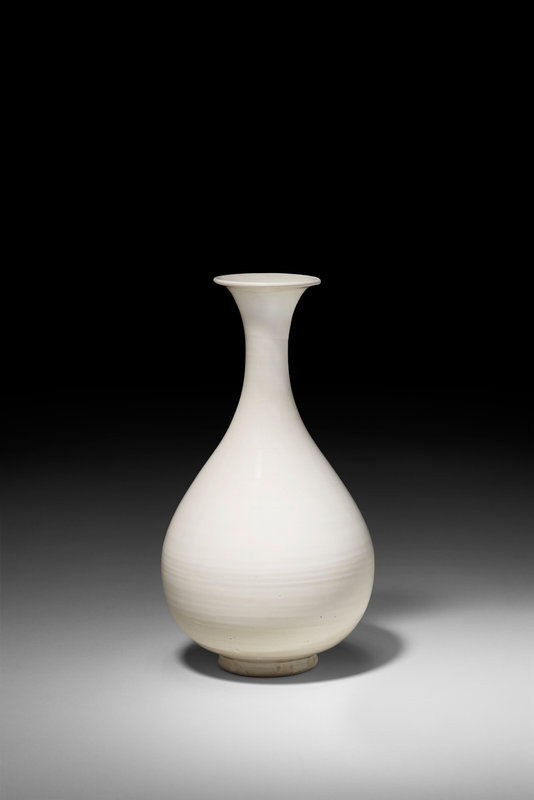

Lot 862. A glazed white porcelain pear-shaped vase, yuhuchunping, Northern Song dynasty, 10th–11th century; 10 3/4 in. (27.3 cm.) high, cloth box. Estimate USD 30,000 – USD 40,000. Price Realised USD 100,800 © Christie's 2023
The vase has a tapering ovoid body rising to the slender, waisted neck and flared mouth rim, and is covered in a clear glaze of very pale ivory tone that ends unevenly above the foot. The base is inscribed with two characters in black ink possibly reading zhou X.
Provenance: J. J. Lally & Co., New York, no. 4607.
Note: The elegant yuhuchunping form, possibly used as a decanter of wine, was eminently suitable to grace the tables of the refined Song elite. When William Watson illustrated a similar vase in Tang and Liao Ceramics, London, 1984, pl. 63, he noted that this form is “...one of the purest expressions of the feeling for delicately curving, unarticulated profiles which grew through the Five Dynasties period into the Northern Song.” This similar vase, from the Collection of Mr. and Mrs. Eugene Bernat, was previously illustrated in The Ceramic Art of China, London, 1971 no. 57, pl. 40.
See, also, other similar vases, one from the Charles B. Hoyt Collection in the Boston Museum of Fine Arts, illustrated in the Memorial Exhibition Catalogue, 1952, pl. 88, no. 349; one in the Hakone Art Museum, Japan, illustrated in Mayuyama, Seventy Years, 1976, vol. 1, no. 637; one in The Metropolitan Museum of Art, New York, illustrated by S. Valenstein in The Herzman Collection of Chinese Ceramics, New York, 1992, no. 25 and one in Born of Earth and Fire, Chinese Ceramics from the Scheinman Collection, 1992, no. 57.
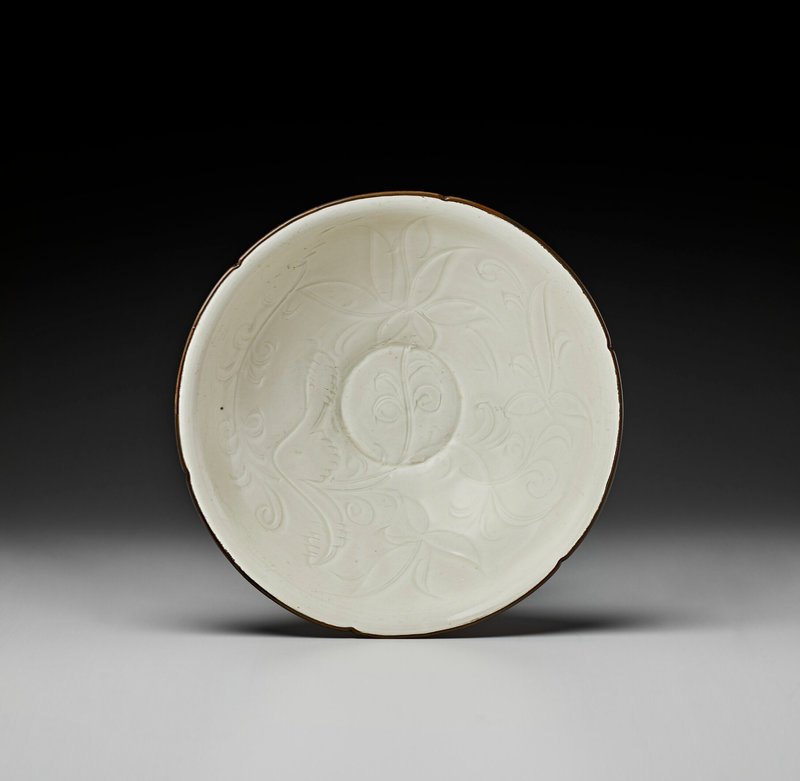

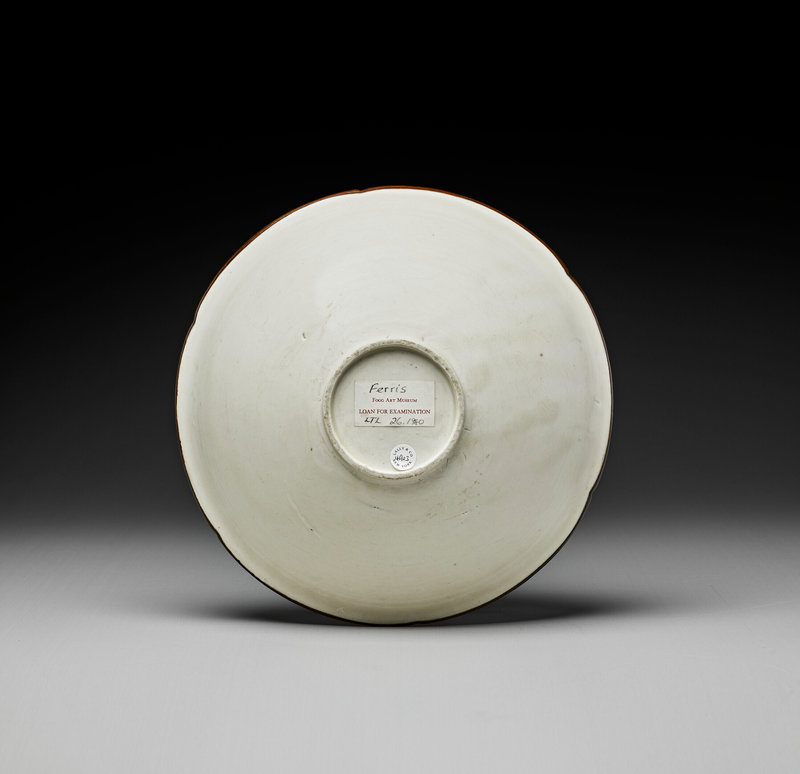

Lot 863. A superb carved Ding 'lotus' bowl, Northern Song dynasty (960-1127); 8 7/8 in. (22.5 cm.) diam., cloth box, wood box. Estimate USD 200,000 – USD 300,000. Unsold. © Christie's 2023
The bowl is freely carved on the interior with a large lotus blossom borne on a slender stem enclosed by leaves and curling tendrils, all beneath the petal-lobed rim which is bound with a copper band. The bowl is covered overall in a transparent glaze of pale ivory tone.
Provenance: Francis Stewart Kershaw (1869-1930) Collection, Boston.
Sotheby Parke Bernet New York, 20 March 1976, lot 83.
Robert Ferris Collection, Windsor, Vermont, 1976-1997.
Private American collection, 1997-2019.
J. J. Lally & Co., New York, 1997, no. 4903.
Literature: J. J. Lally & Co., Brush & Clay: Paintings by Robert Ferris and Chinese Ceramics of the Song Dynasty from the Artist's Collection, New York, 1997, no. 21.
Exhibited: On loan: Cambridge, Massachusetts, Fogg Art Museum, Harvard University.
On loan: Minneapolis, Minneapolis Institute of Arts.
New York, J. J. Lally & Co., Brush & Clay: Paintings by Robert Ferris and Chinese Ceramics of the Song Dynasty from the Artist's Collection, 19 September-18 October 1997, no. 21.
Note: This superb bowl is a classic example of the Song-dynasty Ding ware bowls which have been greatly admired by literati and officials since their initial manufacture. In the poem Shiyuan jiancha (Tea Brewing in the Examination Hall), the esteemed Song-dynasty literatus Su Shi recalls an event where tea turned red against a caved Ding white-glazed bowl, resembling carved red jade. This poem reveals both that Ding bowls were used for tea drinking, and more importantly, that they were favored by the literati at the time. Interestingly, in 1093, two decades after Su Shi wrote the poem, he was appointed Governor of Dingzhou, the province where the Ding kilns were located. Su Shi’s praise solidified the status of Ding porcelains amongst subsequent connoisseurs, such as the Jin-dynasty scholar Liu Qi (1203–1259), who wrote in a poem Dingzhou huaciou, yanse tianxia bai (decorated porcelain bowls from Dingzhou have the best white color under Heaven).
The current bowl is particularly distinguished for its elegant form, fluid carving and resplendent glaze. A hexafoil bowl of similar form and size, but with lotus carved in a slightly different style, in the Beijing Palace Museum Collection, is illustrated in Zhongguo taoci quanji – Dingyao, Shanghai, 1981, pl. 90. See, also, the Ding hexafoil bowl sold at Christie’s Hong Kong, 26 November 2018, lot 8005.
Other comparable Ding bowls with carved lotus design include a further example in the Palace Museum, Beijing, illustrated in The Complete Collection of Treasures of the Palace Museum - 32 - Porcelain of the Song Dynasty (I), Hong Kong, 1996, p. 60, no. 52, from the Qing court collection; in the National Palace Museum, Taipei, illustrated in Gugong songci tulu (Illustrated Catalogue of Sung Dynasty Porcelain in the National Palace Museum), Ting Ware and Ting-Type Ware, Taipei, 1973, no.18; in the British Museum from the Oppenheim Collection, illustrated by J. Rawson in The World’s Great Collections: Oriental Ceramics, Vol. 5, The British Museum, London, Tokyo, 1981, col. pl. 20; in the Museum of Far Eastern Antiquities, illustrated by J. Wirgin, ‘Sung Ceramics Designs’, B.M.F.E.A. No. 42, Stockholm, 1970, pl. 60; and the example illustrated by D. Leidy in the Asia Society, illustrated inTreasures of Asian Art – The Asia Society’s Mr. and Mrs. John D. Rockefeller 3rd Collection, New York, 1994, no. 144, p. 154; in the Newark Museum from the Jaehne Collection, illustrated by Reynolds and Pei, Chinese Art from the Newark Museum, China Institute, New York, 1980, no. 13, p. 31; and in the Idemitsu Museum, illustrated in Chinese Ceramics in the Idemitsu Collection, Tokyo, 1987, no. 413.
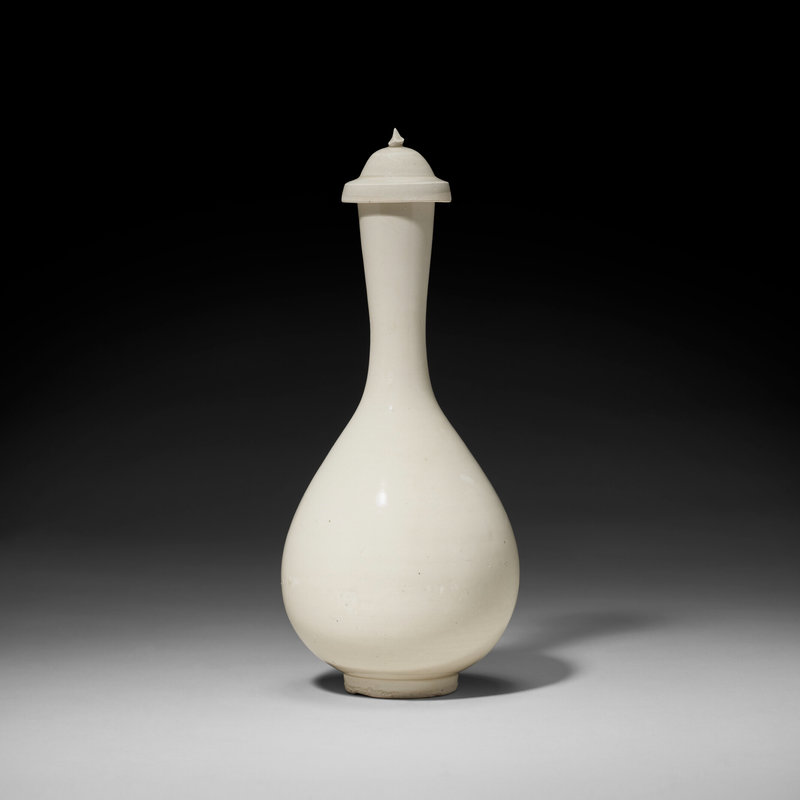
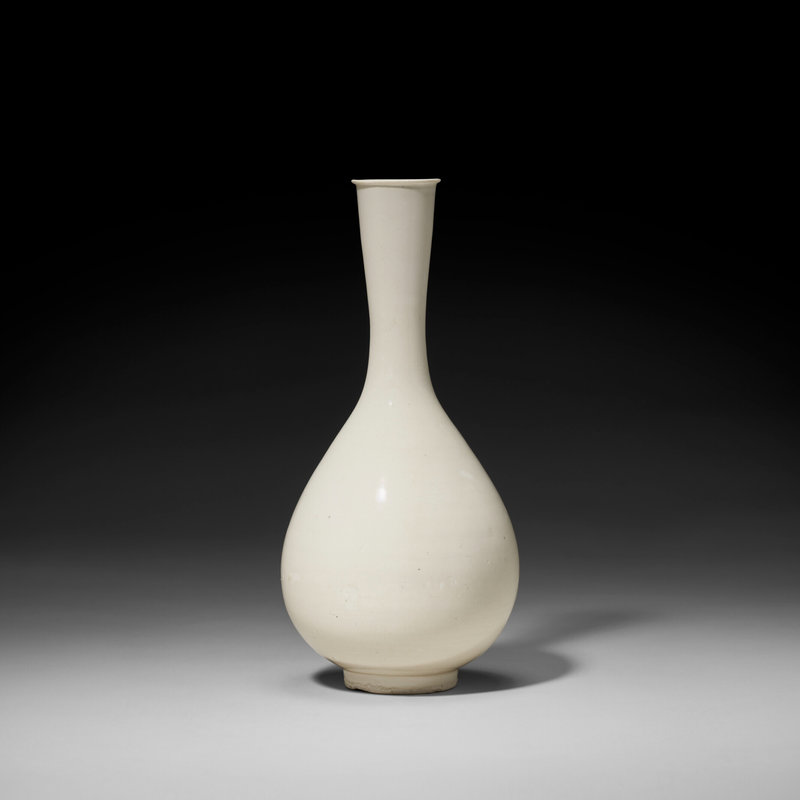

Lot 864. A very rare Ding bottle vase and cover, Northern Song-Jin dynasty, 12th century; Vase: 11 3/4 in. (29.8 cm.) high; And cover: 13 1/8 in. (33.3 cm.) high, cloth box. Estimate USD 80,000 – USD 100,000. Price Realised USD 207,900. © Christie's 2023
The elegant pear-shaped body tapers to a tall, slender neck rising to a slightly flared mouth with lipped rim. The domed cover is surmounted by a bud-shaped finial. Both are covered overall with a clear glaze shading to a pale creamy tone in some places.
Provenance: J. J. Lally & Co., New York, no. 3900.
Note: It is extremely rare to find vases of this type with a cover. A very similar bottle-vase without a cover in the Carl Kempe Collection is illustrated by B. Gyllensvärd in Chinese Ceramics in the Carl Kempe Collection, Stockholm, 1964, p. 118, no. 359. Also, see, a similar version, without cover, in the Idemitsu Museum, illustrated in Chinese Ceramics in the Idemitsu Collection, Tokyo, 1987, col. pl. 84. The same vase was previously illustrated in Teiyo hakuji (White Porcelain of Dingyao), Tokyo, 1983, p. 68, no. 112.
Another similar white porcelain bottle-vase from a mural tomb in Luoyang, Henan province is illustrated in Wenwu, 1992, No. 12, p. 49, pl. 39, with a line drawing, pl. 34-2. The same vase is illustrated again by Zhang (ed.), Zhongguo chutu ciqi quanji (Complete Collection of Ceramic Art Unearthed in China), vol. 12, Henan, Beijing, 2007, p. 175, no. 175, described as Jin dynasty and is currently in the collection of the Luoyang Museum.
A silver bottle-vase and cover of the same shape as the present vase, in the Nelson Atkins Museum of Art, is illustrated by R. Ward and P. Fidler (eds.) in The Nelson-Atkins Museum of Art: A Handbook of the Collection, New York, 1993, p. 339.

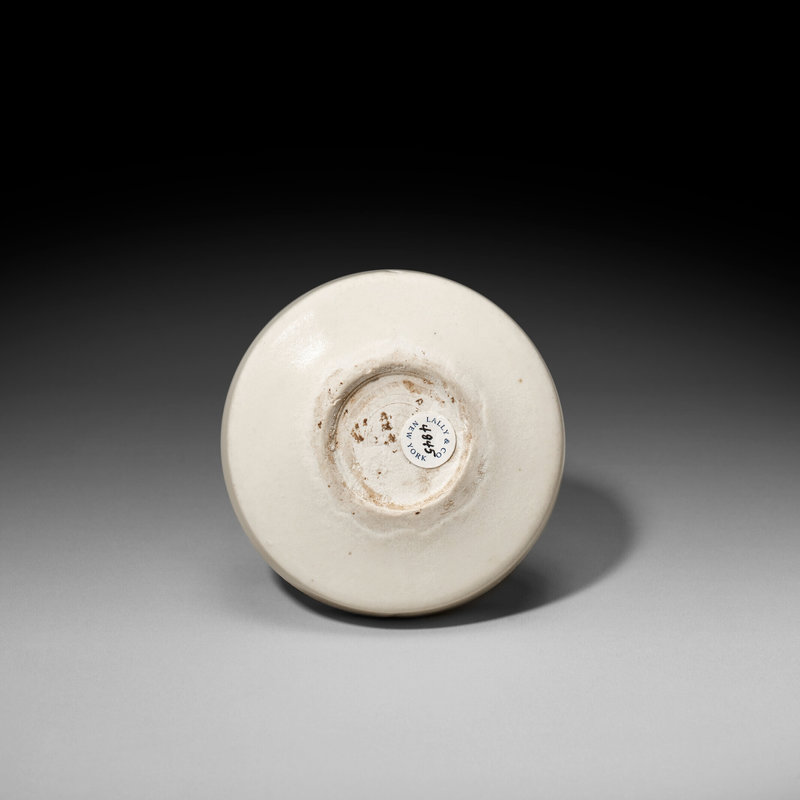
Lot 866. A small glazed white porcelain box and cover, Northern Song dynasty (960-1127); 3 1/4 in. (8.3 cm.) diam., cloth box. Estimate USD 15,000 – USD 25,000. Unsold. © Christie's 2023
The box has straight narrow sides, with the underside angled in to a small ring foot enclosing a recessed base, and with a slightly domed cover. The box and cover are covered with a white slip and a transparent, ivory-tone glaze, which ends in an uneven line around the foot of the box.
Provenance: J. J. Lally & Co., New York, no. 4845.
Note: Boxes of this shape can also be found in Ding ware. A Ding box and cover of similar shape is illustrated by R. Krahl in Chinese Ceramics from the Meiyintang Collection, Volume Three (II), London, 2006, p. 435, no. 1433, where the author cites a similar box and cover discovered in 1985 amongst a group of Ding white porcelains from a tomb at Nanxinzhuang, Haidian district, Beijing municipality, dated to the early Jin period (AD 1125-1160).


Lot 867. A carved Ding 'daylily' bowl, Northern Song-Jin dynasty, 12th century; 8 1/8 in. (20.7 cm.) diam., cloth box. Estimate USD 40,000 – USD 60,000. Unsold. © Christie's 2023
The bowl has rounded sides that rise from the narrow foot and flaring slightly to the unglazed rim, and is boldly carved in the interior with a daylily spray bearing three large blossoms with tightly curled leaves. It is covered overall with an ivory-tinted clear glaze.
Provenance: J. J. Lally & Co., New York, no. 4739.
Note: A very similar 'daylily' Ding bowl, but with a band at the rim, from the Qing Court Collection and now in the Palace Museum, Beijing, is illustrated in The Complete Collection of Treasures of the Palace Museum - 32 - Porcelain of the Song Dynasty (I), Hong Kong, 1996, p. 60, no. 52. Another Ding bowl carved with a daylily spray on the interior is in the National Palace Museum, Taipei, and illustrated in Dingzhou huaci: yuancang Dingyao xi baici tezhan (Decorated Porcelains of Dingzhou: White Ding Wares from the Collection of the National Palace Museum), Taipei, 2013, p. 93, no. II-46.
The dating of this bowl is consistent with the results of a thermoluminesence test by C-Link, certificate no. 1433ZA08.


Lot 869. A finely molded Ding bowl, Northern Song-Jin dynasty, 12th century; 6 1/2 in. (16.3 cm.) diam., cloth box. Estimate USD 40,000 – USD 60,000. Price Realised USD 100,800. © Christie's 2023
The bowl has gently rounded sides rising to a notched, unglazed rim and is crisply molded on the interior with four peony blossoms borne on leafy stems enclosing a floral spray in the recessed center, all below a narrow keyfret border. It is covered overall with a clear glaze of faint ivory tone continuing over the small ring foot and recessed base.
Provenance: J. J. Lally & Co., New York, no. 4263.
Note: Molded decoration on Ding wares was adopted in the latter part of the Northern Song dynasty (AD 960-1127) and flourished during the Jin dynasty (1115-1234). A similar lobed molded Ding bowl of larger size similarly decorated with sprays of peony blossoms and keyfret border, in the National Palace Museum, Taipei, is illustrated in the exhibition catalogue Dingzhou huaci: yuan cang Dingyai xi baici tezhan (Decorated Porcelains of Dingzhou: White Ding wares from the Collection of the National Palace Museum), Taipei, 2013, p. 164, no. II-106, where it is dated Northern Song-Jin dynasty, 12th century. Another lobed Ding bowl with closely related molded floral decoration, also in the collection of the National Palace Museum, Taipei, is illustrated ibid., p. 165, no. II-107, and dated Jin dynasty, 12th-13th century.




/https%3A%2F%2Fprofilepics.canalblog.com%2Fprofilepics%2F1%2F0%2F100183.jpg)
/https%3A%2F%2Fstorage.canalblog.com%2F03%2F02%2F119589%2F96711876_o.jpg)
/https%3A%2F%2Fstorage.canalblog.com%2F11%2F31%2F119589%2F94773502_o.jpg)
/https%3A%2F%2Fstorage.canalblog.com%2F20%2F83%2F119589%2F94772815_o.jpg)
/https%3A%2F%2Fstorage.canalblog.com%2F26%2F72%2F119589%2F75604929_o.jpg)
/https%3A%2F%2Fstorage.canalblog.com%2F59%2F60%2F119589%2F26458628_o.jpg)
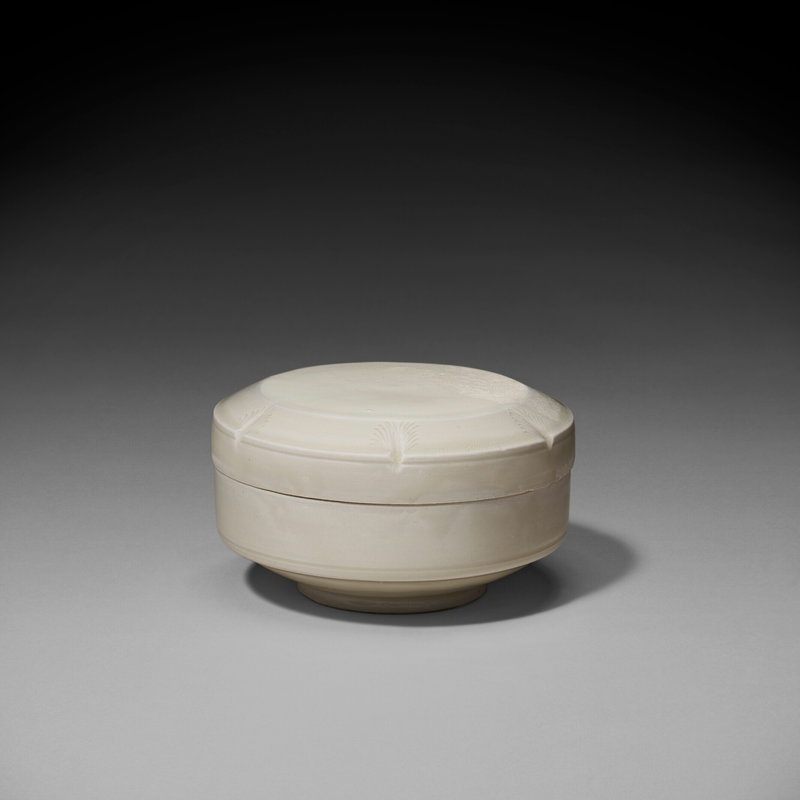






























/image%2F1371349%2F20240411%2Fob_4a5248_2024-nyr-22642-0913-000-a-longquan-cel.jpg)
/image%2F1371349%2F20240410%2Fob_b0ef72_2024-nyr-22642-0908-000-a-carved-ding.jpg)
/http%3A%2F%2Fstorage.canalblog.com%2F29%2F47%2F119589%2F129819867_o.jpg)
/http%3A%2F%2Fstorage.canalblog.com%2F93%2F57%2F119589%2F129818552_o.jpg)